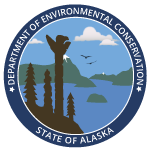Water Quality Standards Section
A water quality standard defines the water quality goals of a water body or portion of, by designating the use to be made of the water and criteria for the protection of designated uses. Alaska’s water quality standards are identified at
Water quality standards are used in the development of wastewater permits, waterbody monitoring plans, and waterbody recovery goals. The adoption of new and/or modifications to the existing water quality standards are subject to public participation requirements. It is important to note that water quality standards are different than those used for the regulation of public drinking water (i.e. drinking water regulations). More information about the regulation of drinking water is available through the DEC Drinking Water Program.
Current Rulemaking Proposals
State Resources
- Alaska Water Quality Criteria Manual for Toxic and other Deleterious Organic and Inorganic Substances (2022)
- Inorganic Toxics Criteria Worksheet Updated: 01/11/2024
- History of Alaska’s WQS
Federal Resources
- 40 CFR 131 Water Quality Standards (2015)
- EPA Water Quality Standards Academy: This online resource includes several short key concept modules.
- EPA Water Quality Standards Handbook
- EPA Glossary of Terms
Former versions of 18 AAC 70 Water Quality Standards:
Some sections of these earlier regulations remain in effect for CWA purposes. The Comparison of State and Federally Approved WQS for use with CWA programs provides additional information about this topic.

 Indicates an external site.
Indicates an external site.